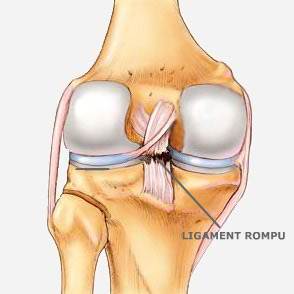Knee Ligament Reconstruction in Tunisia
Definition of Knee Ligament Reconstruction
Ligament reconstruction (also known as ligamentoplasty) is an endoscopic procedure for replacing a surgical tissue graft of the anterior cruciate ligament, a knee ligament, often with a tissue graft taken from your own body.
The anterior cruciate ligament is located in the central part of your knee and stabilizes the knee joint. The surgery will ensure that your knee is stabilized again, avoiding potential damage that could affect the cartilage and meniscus.
Why surgery?
 Ligament reconstruction is sometimes performed if you have suffered a joint trauma strong enough for the ligament to tear in the knee. When your ligament is torn, you will feel intense pain and your knee will be swollen. There may also be fluid regurgitation in the knee.
Ligament reconstruction is sometimes performed if you have suffered a joint trauma strong enough for the ligament to tear in the knee. When your ligament is torn, you will feel intense pain and your knee will be swollen. There may also be fluid regurgitation in the knee.
Trauma can be the result of a sprain or sudden inward rotation of the knee after a fall or excessive extension of the knee.
Why Knee Ligament Reconstruction?
The rupture of the anterior cruciate ligament heals poorly and often in a non-functional way. The repercussions on knee stability are therefore frequent and vary from case to case and mainly depend on the demands placed on the knee. Indeed, certain movements (pivoting with contact), performed particularly during sports practice, cannot be done without an effective Anterior Cruciate Ligament. This ligament injury therefore causes instability of the joint which can manifest as knee giving way. These instability incidents resemble joint subluxations that can cause damage to the cartilage, menisci, and other ligaments. This poor dynamic functioning of the joint eventually leads to progressive degradation of the articular and bone surfaces resulting in osteoarthritis. The goal of anterior cruciate ligament reconstruction is therefore to restore good stability to the joint through this ligament replacement. Thus, sports activities can be resumed under good conditions and, most importantly, meniscal, cartilaginous, and ligament degradation of the knee is avoided. The accelerated arthritic progression is therefore stopped.
Procedure of ACL Surgery
When the anterior cruciate ligament is affected, the stability of the knee is compromised and it is then referred to as a severe knee sprain. It generally occurs during a violent twisting of the knee and is very often a sports injury. The ligament is suddenly subjected to strong tension that tears it, causing knee instability as well as locking sensations experienced during physical activity or during leg rotation movements. The ligament rupture is followed by the retraction of the two broken ends, making any spontaneous reconstruction impossible.
Anterior cruciate ligament reconstruction aims to recover perfect knee stability allowing all types of activities to be performed without risk of injury to the cartilage or menisci that would result in joint degradation.
Ligament reconstruction is indicated as a curative treatment in cases of disabling discomfort resulting from accidents related to knee instability, in professional practice or sports activity, or even in daily life. This may involve giving way, dislocations, or repeated sprains. As a preventive measure, ligament reconstruction prevents any serious accident resulting from loss of stability in young athletes or patients working in high-risk occupations. Reconstruction of the anterior cruciate ligament is also indicated in cases of associated injuries such as damage to the collateral ligaments or posterior ligament, meniscal tears (rarely), or cartilage injuries. The surgeon performs the procedure under arthroscopy (mini-camera introduced inside the knee) for better visualization of joint injuries, treatment of any associated meniscal injuries, and especially adequate placement of the new ligament. Depending on the case, they may adopt one of the main surgical techniques. This involves either harvesting the hamstring tendons (gracilis and semitendinosus "ST-G") from the knee to fix them in place of the anterior cruciate ligament. This is then referred to as ligament reconstruction with ST-G (harvesting of two tendons) or with TLS (technique requiring the harvesting of a single tendon). Or harvesting a bone-tendon-bone graft from the patella, patellar tendon, and tibial tuberosity and fixing them in place of the anterior cruciate ligament. This is then a Kenneth-Jones ligament reconstruction. The harvesting of tendons has no consequence on the final performance of the joint and the new ligament will be fixed by two bio-resorbable or metallic interference screws (bone staples).
The surgery should not last more than 45 minutes and it is an arthroscopic procedure - a form of minimally invasive surgery that can also allow the surgeon to treat other problems at the same time.
Results
The result is very encouraging and is marked by the rapid disappearance of pain, locking sensations, feelings of instability, and the complete recovery of mobility and muscle strength after three to six months.